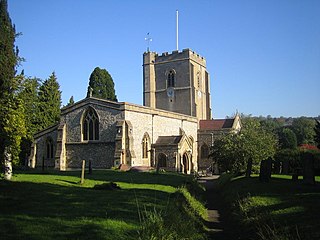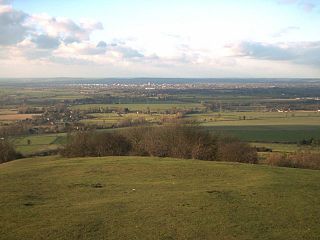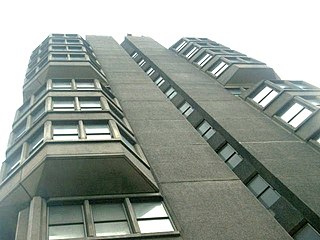
Berkhamsted is a historic market town in Hertfordshire, England, in the Bulbourne valley, 26 miles (42 km) north-west of London. The town is a civil parish with a town council within the borough of Dacorum which is based in the neighbouring large new town of Hemel Hempstead. Berkhamsted, along with the adjoining village of Northchurch, is encircled by countryside, much of it in the Chiltern Hills which is an Area of Outstanding Natural Beauty (AONB).

Aylesbury is the county town of Buckinghamshire, South East England. It is home to the Roald Dahl Children's Gallery and the Waterside Theatre. It is in central Buckinghamshire, midway between High Wycombe and Milton Keynes.

Tring is a market town and civil parish in the Borough of Dacorum, Hertfordshire, England. It is situated in a gap passing through the Chiltern Hills, classed as an Area of Outstanding Natural Beauty, 30 miles (50 km) from Central London. Tring is linked to London by the Roman road of Akeman Street, by the modern A41 road, by the Grand Union Canal and by the West Coast Main Line to London Euston. Settlements in Tring date back to prehistoric times and it was mentioned in the Domesday Book; the town received its market charter in 1315. Tring is now largely a commuter town within the London commuter belt. As of 2013, Tring had a population of 11,731.

The Borough of Dacorum is a local government district in Hertfordshire, England that includes the towns of Hemel Hempstead, Berkhamsted, Tring and Kings Langley. The district, which was formed in 1974, had a population of 137,799 in 2001. Its name was taken from the old hundred of Dacorum which covered approximately the same area. It is the westernmost of Hertfordshire's districts, being bordered to the west by the Chiltern and Aylesbury Vale districts of Buckinghamshire.

South West Hertfordshire is a constituency in the House of Commons of the UK Parliament, represented since 2019 by Gagan Mohindra, a Conservative.
Wing Rural District was a rural district in the administrative county of Buckinghamshire, England. It was created in 1894 with the name Linslade Rural District, but was renamed Wing Rural District in 1897 when Linslade itself was removed from the district to become an urban district. Wing Rural District was abolished in 1974 to become part of Aylesbury Vale District.
Aylesbury was a rural district in the administrative county of Buckinghamshire, England from 1894 to 1974. It was named after but did not include Aylesbury, which was a separate municipal borough.
Wycombe Rural District was, from 1894 to 1974, a rural district in the administrative county of Buckinghamshire, England.
Watford Rural District was a rural district in Hertfordshire from 1894 to 1974. It initially surrounded but did not including the town of Watford, which was a separate urban district. It gradually ceded territory to other districts, and by the time of its abolition in 1974 the district comprised three separate pieces of land, lying to the north-west, north-east, and south of Watford.
Tring Rural is a civil parish in Hertfordshire, England. It includes the villages of Long Marston, Wilstone, Puttenham, and the hamlets of Gubblecote and Astrope. It is largely situated to the north-west of the town of Tring. The town of Tring itself is not part of the parish.

Cow Roast is a hamlet within the civil parishes of Northchurch and Wigginton in Hertfordshire, England. It is between Tring and Berkhamsted, along the A4251, adjacent to the Grand Union Canal and the West Coast Main Line. Today it comprises a row of 20th-century houses and a marina, together with several older properties including a public house. There are three car dealerships and a petrol station beside the main road.

The town of Chesham formed a local government district in the administrative county of Buckinghamshire, England from 1884 to 1974. It was administered as a local government district from 1884 to 1894, and as an urban district from 1894 to 1974.

Northchurch is a village and civil parish in the Bulbourne valley in the county of Hertfordshire in the United Kingdom. It lies between the towns of Berkhamsted and Tring.
Linslade was an urban district in the administrative county of Buckinghamshire, England from 1897 to 1965.

The town of Aylesbury formed a local government district in Buckinghamshire, England from 1849 to 1974. It was administered as a local board district from 1849 to 1894, as an urban district from 1894 to 1916, and as a municipal borough from 1917 until its abolition in 1974.

The Aylesbury Vale is a geographical region in Buckinghamshire, England, which is bounded by the City of Milton Keynes and West Northamptonshire to the north, Central Bedfordshire and the Borough of Dacorum (Hertfordshire) to the east, the Chiltern Hills to the south and South Oxfordshire to the west. It is named after Aylesbury, the county town of Buckinghamshire. Winslow and Buckingham are among the larger towns in the vale.

County Hall is a high-rise tower block in Walton Street in Aylesbury, in the county of Buckinghamshire in England. It was built to house the former Buckinghamshire County Council. Following local government reorganisation in 2020 the building is now owned by Buckinghamshire Council. County Hall continues to be used as offices by the new council, but meetings of the council are held at The Gatehouse in Aylesbury, the former offices of Aylesbury Vale District Council.

Aylesbury Town Hall is a name which has been used for two different buildings in Aylesbury, Buckinghamshire, England. Since 2007 the name has been used for an office building at 5 Church Street, which serves as the headquarters of Aylesbury Town Council. The name was also formerly used for a complex of buildings which had been built in 1865 as a corn exchange in Market Square, and which served as the offices and meeting place of the local council from 1901 to 1968. The majority of the old town hall was demolished shortly afterwards, leaving only the entrance archway facing Market Square still standing, now called Town Hall Arches. This remaining part of the old town hall is a Grade II* listed building as part of the range of civic buildings on the southern side of Market Square including the old County Hall.
Berkhamsted Rural District was a rural district in Hertfordshire, England from 1894 to 1974, covering an area to the west of the county. Until 1937 the official spelling of the district's name was Berkhampstead Rural District.

Berkhamsted Civic Centre is a municipal building in the High Street in Berkhamsted in Hertfordshire, England. The structure accommodates the offices and meeting place of Berkhamsted Town Council.













